Starknet & eTukTuk Continue to Rally Despite Other Altcoins Falling

The altcoin market has experienced a volatile 24 hours, with many tokens experiencing a pullback.
However, Starknet (STRK) continues to defy this bearish momentum and is powering higher.
Even more intriguing is the emergence of eTukTuk (TUK), a new eco-friendly transportation project turning heads in its presale phase.
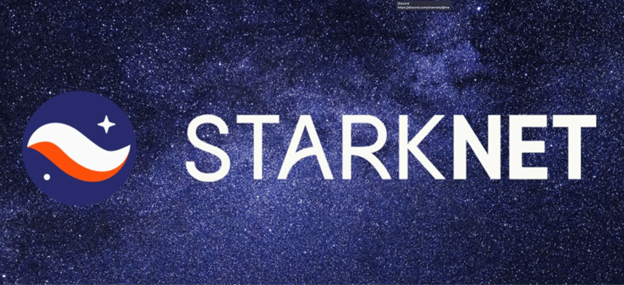
Starknet Soars Amid Crypto Market Turbulence
STRK has surged to the $2.40 level, marking a stunning 39% increase in just 24 hours.
This surge has been accompanied by an 89% increase in spot trading volume, pushing Starknet into the top 20 most traded cryptocurrencies globally.
Technical analysis reveals a significant breakout for Starknet as it smashed through the key resistance of $2.00.
This bullish momentum suggests further upside potential in the near term.
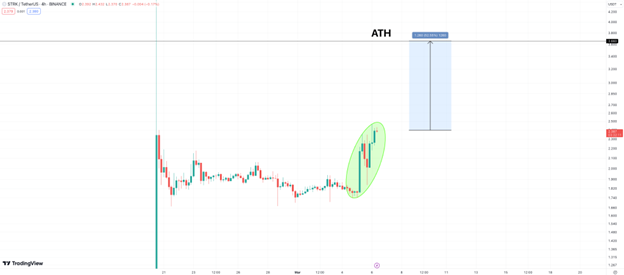
Starknet’s bullishness has contrasted with the broader market’s lackluster performance.
Bitcoin (BTC), the king of crypto, dropped 14% yesterday after posting a new all-time high of $69,170.
Ethereum (ETH) also experienced a sharp pullback yet has now rebounded to the $3,830 level.
Amidst this volatility, STRK has continued to gain momentum, with data from etherscan.io showing there are now over 2,900 token holders.
However, with STRK still 52% away from February’s all-time high, there’s plenty of room for further growth as the bull run continues.
Is Starknet Ethereum’s Layer-2 Savior?
While there hasn’t been a specific catalyst for Starknet’s recent surge, speculation is mounting that investors are becoming increasingly aware of its use cases.
Starknet operates as a layer-2 scaling solution for the Ethereum blockchain.
This means Starknet enables Ethereum to process far more transactions through advanced validation models that maintain user security.
STRK is the native token of the Starknet ecosystem and can be used for governance and staking.
Starknet’s potential to make Ethereum faster and more affordable is vital to its appeal, and the STRK token is essential to facilitate this functionality.
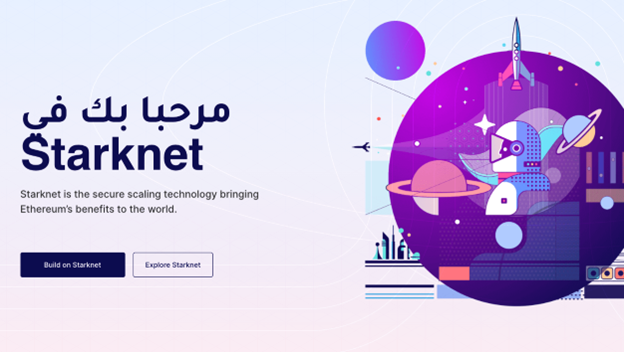
The rise of layer-2 solutions like Starknet is a testament to the growing demand for scalability in the Ethereum ecosystem.
As more users and developers flock to Ethereum, the network has struggled with high gas fees and slow transaction speeds.
For example, according to etherscan.io’s Ethereum Gas Tracker, the current average fee for an NFT sale is $184.
Unsurprisingly, investors are unhappy about the level of these fees, which is why layer-2 solutions have become so popular.
Since Starknet is the latest layer-2 solution to gain traction, it’s no surprise that STRK’s price is surging.
eTukTuk Emerges as Eco-Friendly Crypto to Watch After Raising $1.7m
While Starknet’s surge is turning heads in the crypto market, another project is quietly generating excitement: eTukTuk.
Currently in its presale phase, this innovative transportation initiative is receiving attention for its eco-friendly ambitions and potential to bring positive change to developing nations.
eTukTuk aims to revolutionize transport with AI-powered electric tuk-tuks and blockchain-supported charging infrastructure.
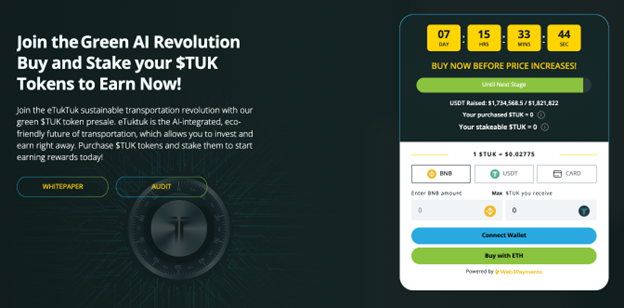
The TUK token is at the heart of this ecosystem, powering everything from AI-driven efficiency optimizations to predictive maintenance.
As outlined in eTukTuk’s whitepaper, the development team has an exciting roadmap, which includes a play-to-earn (P2E) game that will enable players to earn more TUK tokens.
eTukTuk also features a staking program offering up to 140% yields for early investors.
Those looking to gain exposure to eTukTuk’s growth can participate in the limited-time presale, which has raised over $1.7 million so far.
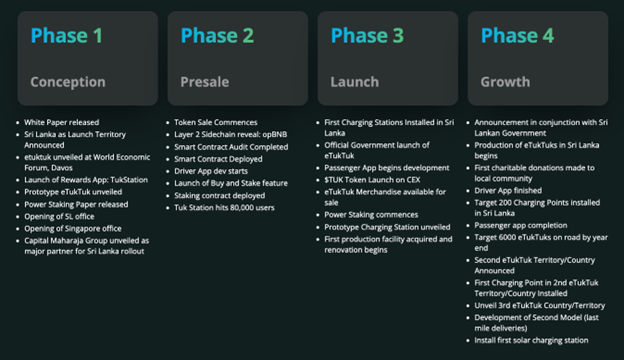
Investors worldwide have been clamoring to get involved since TUK tokens are on offer at a discounted price.
Once the presale hits its hard cap of $10.7 million, the development team plans to secure listings for TUK on several top exchanges.
Given its eco-friendly nature and innovative use case, eTukTuk could become a major player in the green transportation revolution.
Visit eTukTuk Presale
Disclaimer: The above article is sponsored content; it’s written by a third party. CryptoPotato doesn’t endorse or assume responsibility for the content, advertising, products, quality, accuracy, or other materials on this page. Nothing in it should be construed as financial advice. Readers are strongly advised to verify the information independently and carefully before engaging with any company or project mentioned and do their own research. Investing in cryptocurrencies carries a risk of capital loss, and readers are also advised to consult a professional before making any decisions that may or may not be based on the above-sponsored content.
Readers are also advised to read CryptoPotato’s full disclaimer.
The post Starknet & eTukTuk Continue to Rally Despite Other Altcoins Falling appeared first on CryptoPotato.
Starknet & eTukTuk Continue to Rally Despite Other Altcoins Falling

The altcoin market has experienced a volatile 24 hours, with many tokens experiencing a pullback.
However, Starknet (STRK) continues to defy this bearish momentum and is powering higher.
Even more intriguing is the emergence of eTukTuk (TUK), a new eco-friendly transportation project turning heads in its presale phase.

Starknet Soars Amid Crypto Market Turbulence
STRK has surged to the $2.40 level, marking a stunning 39% increase in just 24 hours.
This surge has been accompanied by an 89% increase in spot trading volume, pushing Starknet into the top 20 most traded cryptocurrencies globally.
Technical analysis reveals a significant breakout for Starknet as it smashed through the key resistance of $2.00.
This bullish momentum suggests further upside potential in the near term.

Starknet’s bullishness has contrasted with the broader market’s lackluster performance.
Bitcoin (BTC), the king of crypto, dropped 14% yesterday after posting a new all-time high of $69,170.
Ethereum (ETH) also experienced a sharp pullback yet has now rebounded to the $3,830 level.
Amidst this volatility, STRK has continued to gain momentum, with data from etherscan.io showing there are now over 2,900 token holders.
However, with STRK still 52% away from February’s all-time high, there’s plenty of room for further growth as the bull run continues.
Is Starknet Ethereum’s Layer-2 Savior?
While there hasn’t been a specific catalyst for Starknet’s recent surge, speculation is mounting that investors are becoming increasingly aware of its use cases.
Starknet operates as a layer-2 scaling solution for the Ethereum blockchain.
This means Starknet enables Ethereum to process far more transactions through advanced validation models that maintain user security.
STRK is the native token of the Starknet ecosystem and can be used for governance and staking.
Starknet’s potential to make Ethereum faster and more affordable is vital to its appeal, and the STRK token is essential to facilitate this functionality.

The rise of layer-2 solutions like Starknet is a testament to the growing demand for scalability in the Ethereum ecosystem.
As more users and developers flock to Ethereum, the network has struggled with high gas fees and slow transaction speeds.
For example, according to etherscan.io’s Ethereum Gas Tracker, the current average fee for an NFT sale is $184.
Unsurprisingly, investors are unhappy about the level of these fees, which is why layer-2 solutions have become so popular.
Since Starknet is the latest layer-2 solution to gain traction, it’s no surprise that STRK’s price is surging.
eTukTuk Emerges as Eco-Friendly Crypto to Watch After Raising $1.7m
While Starknet’s surge is turning heads in the crypto market, another project is quietly generating excitement: eTukTuk.
Currently in its presale phase, this innovative transportation initiative is receiving attention for its eco-friendly ambitions and potential to bring positive change to developing nations.
eTukTuk aims to revolutionize transport with AI-powered electric tuk-tuks and blockchain-supported charging infrastructure.

The TUK token is at the heart of this ecosystem, powering everything from AI-driven efficiency optimizations to predictive maintenance.
As outlined in eTukTuk’s whitepaper, the development team has an exciting roadmap, which includes a play-to-earn (P2E) game that will enable players to earn more TUK tokens.
eTukTuk also features a staking program offering up to 140% yields for early investors.
Those looking to gain exposure to eTukTuk’s growth can participate in the limited-time presale, which has raised over $1.7 million so far.

Investors worldwide have been clamoring to get involved since TUK tokens are on offer at a discounted price.
Once the presale hits its hard cap of $10.7 million, the development team plans to secure listings for TUK on several top exchanges.
Given its eco-friendly nature and innovative use case, eTukTuk could become a major player in the green transportation revolution.
Visit eTukTuk Presale
Disclaimer: The above article is sponsored content; it’s written by a third party. CryptoPotato doesn’t endorse or assume responsibility for the content, advertising, products, quality, accuracy, or other materials on this page. Nothing in it should be construed as financial advice. Readers are strongly advised to verify the information independently and carefully before engaging with any company or project mentioned and do their own research. Investing in cryptocurrencies carries a risk of capital loss, and readers are also advised to consult a professional before making any decisions that may or may not be based on the above-sponsored content.
Readers are also advised to read CryptoPotato’s full disclaimer.
The post Starknet & eTukTuk Continue to Rally Despite Other Altcoins Falling appeared first on CryptoPotato.